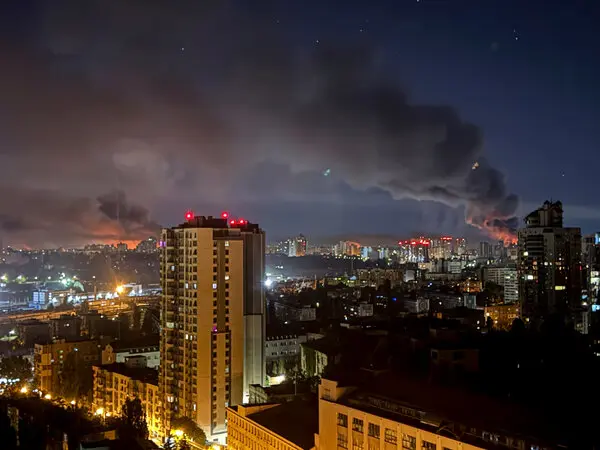Late Friday night, Russia unleashed its most intense aerial assault on Ukraine since the full‑scale invasion began in February 2022. In a barrage spanning more than eight hours, the Russian military deployed 539 drones and 11 missiles against targets across six of Kyiv’s ten districts, damaging homes, public facilities and critical infrastructure while wounding at least 23 people reuters.com.
Deadly Barrage on Kyiv
As air raid sirens wailed across the capital from dusk until dawn, residents huddled in underground stations and basements for safety. In the Solomianskyi district, a five‑story apartment block took a direct hit, and in Sviatoshynskyi a massive fire engulfed the roof of a seven‑story building. Authorities said around 40 residential buildings, five schools, several cafes and part of the city’s passenger railway network sustained damage. Even the Polish embassy’s consular section was struck, though staff were unharmed reuters.com.
Local volunteer rescuers and nearly a hundred emergency crews were on the scene by early morning. Mayor Vitali Klitschko reported that 14 of the injured had been hospitalized. Smoke and dust lingered over Kyiv’s downtown as firefighters worked to control blazes and clear debris, while air defense units claimed to have shot down 478 of the incoming drones and missiles reuters.com.
Diplomatic Stalemate
The timing of the attack sent a stark message of defiance just hours after U.S. President Donald Trump concluded a phone call with Russian President Vladimir Putin. Trump told reporters that the hour‑long discussion yielded “no progress at all” toward peace in Ukraine, a statement that underscored the deep divisions at the core of current diplomacy politico.eu.

In Kyiv, President Volodymyr Zelenskiy condemned the strike as “deliberately massive and cynical,” noting that the first alerts sounded almost simultaneously with media reports of the Trump‑Putin conversation. He urged Western allies to maintain and ramp up pressure on Moscow, particularly by supplying more air defense systems to prevent further damage to civilians.
Rising Toll and Wider Impacts
Beyond the immediate human cost, the strike disrupted daily life for thousands of civilians. Ukraine’s state railway diverted passenger trains, resulting in delays and cancellations. School officials in affected districts announced closures while they assessed structural safety. Small businesses near impact zones remain closed as owners survey rubble and shattered windows.
The attack also raises questions about Ukraine’s defense capacity in the face of U.S. announcements to pause some missile shipments. With the Pentagon citing stockpile concerns, Ukrainian officials worry that reduced access to critical interceptors will embolden further Russian strikes reuters.com.
What Lies Ahead
Russian officials have dismissed calls for a ceasefire. A Kremlin aide reiterated that Moscow will press on with its war aims and address what it calls the conflict’s “root causes,” a phrase Kremlin spokespeople use to justify their campaign in Ukraine. Meanwhile, NATO partners are reviewing their military aid commitments even as Ukraine appeals directly to Washington for renewed support.
On the ground, Kyiv’s air defenses remain active, but prolonged barrages risk stretching resources thin. Humanitarian groups are preparing for additional waves of displacement as residents in damaged areas seek shelter, and local authorities face the daunting task of rebuilding critical services and homes before the next assault.
Personal Analysis
This latest barrage highlights a widening gap between diplomatic posturing and battlefield realities. While leaders exchange calls and statements, armed conflict rages unabated below. The attack’s scale suggests that Moscow sees little value in pausing to negotiate, even when high‑profile talks occur. For Kyiv and its allies, the challenge lies in bolstering defense capabilities fast enough to protect civilians while pursuing every available diplomatic channel. Without sustained and tangible support from partners, Ukraine risks being pushed back into a reactive stance, forced to defend each city block rather than shape a path toward lasting peace.

